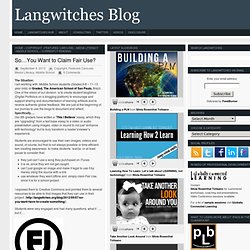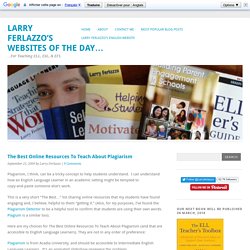

So…You Want to Claim Fair Use? The Situation: I am working with Middle School students (Grades 6-8 – 11-13 year olds) at Graded, The American School of Sao Paulo, Brazil.

One of the vision of our division is to create student blogfolios (Digital Portfolios on a blogging platform) to encourage and support sharing and documentation of learning artifacts and to receive authentic global feedback. We are just at the beginning of our journey to use the blogs to document and reflect. Specifically…. Our 8th graders have written a “This I Believe” essay, which they are “upgrading” from a text base essay to a video or audio presentation using images, video or sound to not just “enhance with technology” but to truly transform a reader’s/viewer’s experience. Students are encouraged to use their own images, videos and sound, of course, but that is not always possible or time efficient. I exposed them to Creative Commons and pointed them to several resources to be able to find images that they can use in their project The Question?
Copyright for Educators. The Copyright Genie. Plagiarism. You have something in common with the smartest people in the world.

You see, everyone has ideas. We use our minds to create something original, whether it’s a poem, a drawing, a song, or a scientific paper. Some of the most important ideas are published and make it into books, journals, newspapers and trustworthy websites that become the building blocks for things we all learn. But ideas are also very personal, and we need dependable ways to keep track of the people behind the ideas we use because they deserve credit for their contribution, just as you do if someone uses your idea. Passing off another person’s ideas or words as your own, without credit, is called plagiarism. Meet Cassie, a university student. She’s not the kind of person who would plagiarize by turning in someone else’s work, but she is aware that plagiarism can happen accidentally, so she follows some basic rules: Second, she’s careful to use only her own words when she’s not quoting directly.
The Best Online Resources To Teach About Plagiarism. Plagiarism, I think, can be a tricky concept to help students understand.

I can understand how an English Language Learner in an academic setting might be tempted to copy-and-paste someone else’s work. This is a very short “The Best…” list sharing online resources that my students have found engaging and, I believe, helpful to them “getting it.” (Also, for my purposes, I’ve found the Plagiarism Detector to be a helpful tool to confirm that students are using their own words. Plagium is a similar too). Here are my choices for The Best Online Resources To Teach About Plagiarism (and that are accessible to English Language Learners). Plagiarism is from Acadia University, and should be accessible to Intermediate English Language Learners. The Monash University Library has an accessible quiz where users have to choose if examples show plagiarism or not.
Lycoming College has a simple slideshow on plagiarism. Mt. Academic Integrity is from Ryerson University. What Is Plagiarism? E.L.L. Related.